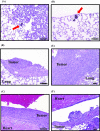Difference in carcinogenicities of two different vapor grown carbon fibers with different physicochemical characteristics induced by intratracheal instillation in rats
- PMID: 37770972
- PMCID: PMC10537556
- DOI: 10.1186/s12989-023-00547-5
Difference in carcinogenicities of two different vapor grown carbon fibers with different physicochemical characteristics induced by intratracheal instillation in rats
Abstract
Background: Carbon fibers are high aspect ratio structures with diameters on the submicron scale. Vapor grown carbon fibers are contained within multi-walled carbon tubes, with VGCF™-H commonly applied as a conductive additive in lithium-ion batteries. However, several multi-walled carbon fibers, including MWNT-7, have been reported to induce lung carcinogenicity in rats. This study investigated the carcinogenic potential of VGCF™-H fibers in F344 rats of both sexes with the vapor grown carbon fibers VGCF™-H and MWNT-7 over 2 years. The carbon fibers were administered to rats by intratracheal instillation at doses of 0, 0.016, 0.08, and 0.4 mg/kg (total doses of 0, 0.128, 0.64, and 3.2 mg/kg) once per week for eight weeks and the rats were observed for up to 2 years after the first instillation.
Results: Histopathological examination showed the induction of malignant mesothelioma on the pleural cavity with dose-dependent increases observed at 0, 0.128, 0.64, and 3.2 mg/kg in rats of both sexes that were exposed to MWNT-7. On the other hand, only two cases of pleural malignant mesothelioma were observed in the VGCF™-H groups; both rats that received 3.2 mg/kg in male. The animals in the MWNT-7 groups either died or became moribund earlier than those in the VGCF™-H groups, which is thought related to the development of malignant mesothelioma. The survival rates were higher in the VGCF™-H group, and more carbon fibers were observed in the pleural lavage fluid (PLF) of the MWNT-7 groups. These results suggest that malignant mesothelioma is related to the transfer of carbon fibers into the pleural cavity.
Conclusions: The intratracheal instillation of MWNT-7 clearly led to carcinogenicity in both male and female rats at all doses. The equivocal evidence for carcinogenic potential that was observed in male rats exposed to VGCF™-H was not seen in the females. The differences in the carcinogenicities of the two types of carbon fibers are thought due to differences in the number of carbon fibers reaching the pleural cavity. The results indicate that the carcinogenic activity of VGCF™-H is lower than that of MWNT-7.
Keywords: 2-Year carcinogenicity study; Carbon fiber; Intratracheal instillation; Mesothelioma; Multi-walled carbon nanotube; Rat; Vapor grown carbon fiber.
© 2023. BioMed Central Ltd., part of Springer Nature.
Conflict of interest statement
K.S., H.F., Y.H., R.O., A.N., T.Y. are employees of the sponsor of this study. T.N., T.S., M.K., Y.M. are employees of DIMS Institute of Medical Sciences Inc. However, this did not influence the objectivity of the study. The authors declare that they have no conflicts of interest.
Figures






Similar articles
-
Two-year intermittent exposure of a multiwalled carbon nanotube by intratracheal instillation induces lung tumors and pleural mesotheliomas in F344 rats.Part Fibre Toxicol. 2022 May 19;19(1):38. doi: 10.1186/s12989-022-00478-7. Part Fibre Toxicol. 2022. PMID: 35590372 Free PMC article.
-
Lung toxicity of a vapor-grown carbon fiber in comparison with a multi-walled carbon nanotube in F344 rats.J Toxicol Pathol. 2021 Jan;34(1):57-71. doi: 10.1293/tox.2020-0064. Epub 2020 Nov 20. J Toxicol Pathol. 2021. PMID: 33627945 Free PMC article.
-
Lung carcinogenicity of inhaled multi-walled carbon nanotube in rats.Part Fibre Toxicol. 2016 Oct 13;13(1):53. doi: 10.1186/s12989-016-0164-2. Part Fibre Toxicol. 2016. PMID: 27737701 Free PMC article.
-
Exposure of Rats to Multi-Walled Carbon Nanotubes: Correlation of Inhalation Exposure to Lung Burden, Bronchoalveolar Lavage Fluid Findings, and Lung Morphology.Nanomaterials (Basel). 2023 Sep 20;13(18):2598. doi: 10.3390/nano13182598. Nanomaterials (Basel). 2023. PMID: 37764628 Free PMC article. Review.
-
Toxicology and carcinogenesis studies of androstenedione (CAS No. 63-05-8) in F344/N rats and B6C3F1 mice (gavage studies).Natl Toxicol Program Tech Rep Ser. 2010 Sep;(560):1, 7-31,33-171 passim. Natl Toxicol Program Tech Rep Ser. 2010. PMID: 21037592 Review.
Cited by
-
Fullerene and fullerene whisker are not carcinogenic to the lungs and pleura in rat long-term study after 2-week intra-tracheal intrapulmonary administration.Arch Toxicol. 2024 Dec;98(12):4143-4158. doi: 10.1007/s00204-024-03863-7. Epub 2024 Sep 13. Arch Toxicol. 2024. PMID: 39269499 Free PMC article.
References
Publication types
MeSH terms
Substances
LinkOut - more resources
Full Text Sources
Medical

